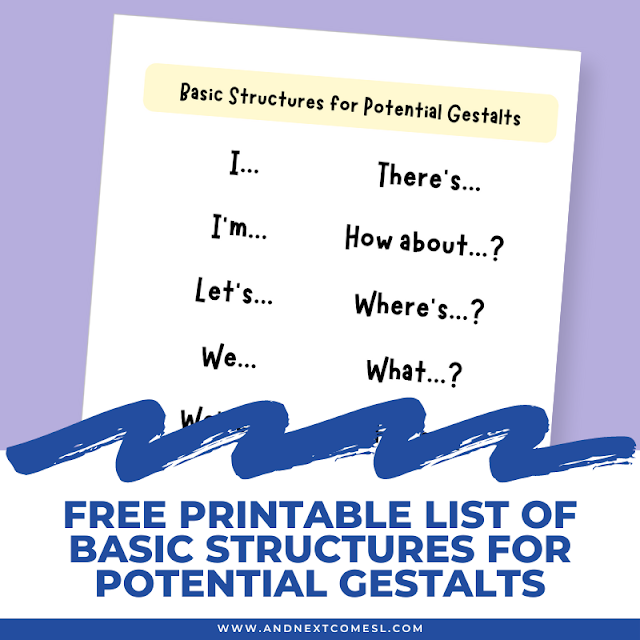When you first learn about gestalt language processing and learn that your child is a gestalt language processor, it can be quite the lightbulb moment.
After all, you know that your child uses a lot of echolalia to communicate and learns language differently. And a different way of learning language requires a different approach to building language skills.
So, for our gestalt language processors (i.e., our hyperlexic/autistic learners), that means picking and modeling gestalts that will be helpful for them as they progress through the stages of Natural Language Acquisition (NLA).
There are a few tips to keep in mind (e.g., tailoring them to the individual child) when it comes to deciding and picking gestalts for your gestalt language processor in the early stages of Natural Language Acquisition. There are also some things that you want to avoid (e.g., "you" and "your" pronouns). So it can be helpful to have some little formulas to get you started.
That's where this list of basic structures for potential gestalts comes in. They're great for kids in stage one (and even stage two).
However, it is worth noting that gestalts don't always have to follow these structures. After all, you can have gestalts that don't use any of these structures, such as "All done!" or "Open it!" or "Not that one!"
So it's best to think of the basic structures below as a starting point.
Basic Structures for Potential Gestalts for Stage 1
When it comes to picking a potential gestalt to model to a child, try these sentence starters:
- I... (e.g., I did it)
- I'm... (e.g, I'm hungry)
- Let's... (e.g., Let's have a snack)
- We... (e.g., We need toothpaste)
- We're... (e.g., We're almost there!)
- It's... (e.g., It's raining, it's pouring...)
- That's... (e.g., That's amazing!)
- There's... (e.g., There's so many!)
- How about...? (e.g., How about another show?)
- Where's...? (e.g., Where's letter Q?)
- What...? (e.g., What now?)
- What's...? (e.g., What's next?)
- Wanna... (e.g., Wanna go again?)
- Don't... (e.g., Don't touch that!)
The reason that these structures work so well is that they're versatile and can serve different communicative functions (e.g., protesting, commenting, asking for help). These structures or formulas are also easy to mix and match in later stages. Plus, they reduce the likelihood of pronoun reversals by avoiding those tricky "you" and "your" pronouns.
Now that you know some basic formulas for gestalt language processors in stage one, let's look at that printable list.
Download the Free Printable
Need More Help with Picking Potential Gestalts? Grab this Bundle!
Knowing the basic structures is one thing, but it's nice to have more concrete examples of potential gestalts to model, right? Well, that's where this bundle of example gestalts for NLA stage 1 comes in handy! You'll find tons of potential gestalts to model for a wide variety of settings and activities, from potty training to bedtime and everything in between.
Grab your copy of the potential gestalts bundle
Hopefully, you found this free printable list of basic structures for potential gestalts helpful!







